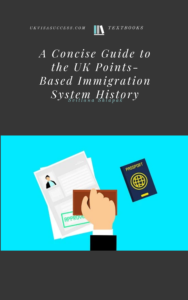The UK’s New post-Brexit Points-Based Immigration System (Part 1 of 2)
Before discussing the changes and the introduction of a new post-Brexit Points-Based Immigration System, let us briefly outline of the old system. From 2021 there will be a lot of changes. To make it an easy and enjoyable read for you, I’ve divided the article into two parts. This is part 1. You can read part 2 next week.
The UK’s New post-Brexit Points-Based Immigration System
History of the Points-Based Immigration System

The system was meant to be a prototype of an Australian immigration system. The Australian immigration system seems to be user-friendly and effective. It works.
The UK Government introduced the UK Points-Based Immigration system at phased stages from 2008 to 2010. It consists of five ‘tiers’, which replaced a notoriously complicated and bulky work permit system which existed in the UK before.
The UK’s New post-Brexit Points-Based Immigration System
Tier 1
Tier 1 is for entrepreneurs, investors and talented people wishing to establish their commercial presence in the UK. There were five Tier 1 routes:
- The route, which is no longer available for new applications: Tier 1 (General)
- Then there is a UK immigration route for entrepreneurs: Tier 1 (Entrepreneur)
- There is also a route for graduate students: Tier 1 (Graduate Entrepreneur)
- Then for investors: Tier 1 (Investor)
- and Tier 1 (Exceptional Talent).
Since its introduction, only Tier 1 (Investor) is still an open route. The Home Office closed all other routes because they did not work the way the UKVI intended them to.
The UK’s New Post-Brexit Points-Based Immigration System
Tier 2
Tier 2 route is predominantly for long-term workers. This is for UK employers wishing to employ someone outside the UK to fulfil a particular vacancy. There are four Tier 2 routes.
- The route for employees: Tier 2 (General)
- For religious workers: Tier 2 (Minister of Religion)
- and sportspersons: Tier 2 (Sportsperson)
- for those, who used to work for a company overseas: Tier 2 (Intra-Company Transfer):
Tier 2 employees are called ‘Sponsors’. They need to have a licence from the Home Office to invite employees from abroad. Licenced sponsors issue a ‘certificate of sponsorship’ to the employees from overseas. You can view a certificate of sponsorship as an invitation to work where the employer also gives their reassurance that they are employing a competent worker who can undertake the job which they hired him.
Tier 4
Tier 4 is for students. Depending on their age, the applicant could either apply under Tier 4 (Child) or Tier 4 (General). Those aged between 16-18 have a choice as they can use both schemes. The Home Office calls educational institutions as ‘Sponsors’. They also need to have a licence from the Home Office to invite students to study in the UK. The Home Office calls their invitations a ’confirmation of acceptance for studies’. Tier 4 sponsor’s duties are different from the duties of Tier 2 sponsors. However, the essence of their responsibilities is the same. The Home Office wants to ensure that the applicants, the Sponsors and the parties’ intentions are genuine.
Tier 5
Tier 5 is for temporary workers. There are two routes. Firstly, it is Tier 5 (Youth mobility). Then there is Tier 5 (Temporary Worker).
Tier 5 (Youth Mobility) is the daughter of a working holidaymaker visa. It allows young citizens (aged 18 to 30) from eight countries to come to the UK for up to two years to work and explore the UK. This route is also open to British overseas citizen, British overseas territories citizen and British national (overseas).
The purpose of Tier 5 (Temporary Worker) visa is similar to that of Tier 2 one. However, Tier 5 (Temporary Workers) has several subcategories tailored for short-term workers.
Where is Tier 3?
In case you are wondering where Tier 3 is gone – Home Office never introduced it. Tier 3 Immigration Routes does not exist.
What was the Idea Behind the Old Points Based System and Did it Work?

The idea behind introducing the PBS was to simplify the UK immigration work-related routes. It did partially work. The system became significantly easier to understand and apply after 2008.
However, the word ‘points-based system’ implied that the applicants could ‘mix and match’ various requirements to succeed in their applications.
For example, the majority of Points-Based System applications have three key components for which the applicants could score points:
- Appendix A (the Attributes, unique features of a particular route) (up to 50 points)
- The applicants will get 10 points from Appendix B (English language)
- and 10 points from Appendix C (maintenance)
So, for the UK points-based system to stay true to its intended nature, the applicants should have been allowed to score points across all three main components of the PBS. So the requirements needed to have flexible and tradable nature.
This is not what happened in reality. In reality, the old PBS operated as a checkbox. If you meet the Appendix A requirement – the box is ticked, if you don’t – the box is not ticked and the application is refused.
Also, as with all major systems, it had various loopholes and imperfections. Some applicants used it not in a way the Home Office intended them to. For this reason, the majority of Tier 1 routes are now closed, and the system is seeing its last days at this stage.
However, in general, the Points-Based System project worked and was partially successful.
The UK’s New Post-Brexit Points-Based Immigration System
From 1 January 2021, we’ll witness the birth of an entirely new Points-Based System. All applicants, from visa, non-visa and EEA countries, will be applying it equally. It will be about the skills and the talents of the applicants and not about their country of origin.
We’ll also experience further improvements to the Tier 2, 4 and 5 sponsorship systems.
Electronic Travel Authorities

The UK government plans to introduce Electronic Travel Authorities. The USA immigration authorities successfully launched their Electronic System for Travel Authorization (ESTA) a number of years ago. It is an automated system that determines the eligibility of visitors to travel to the United States under the Visa Waiver Program. The process is simple, cheap and very straightforward.
As before, all new developments will be introduced very slowly and smoothly, with plenty of time to adapt.
Salary and Skills Thresholds
From 2021 the majority of employer-employee route applicants will need to have a salary of at least £25,600 per year (gross) to qualify. However, some applicants will need to have a higher salary if their occupation is above the general salary threshold. This is also known as the ‘going rate’.
What is incredibly exciting is that that under the new points-based system skilled workers will be able to ‘trade’ requirements (to do a mix and match) and can still succeed even if with a lower salary. In the second part of this article, you’ll see how it works in practice.
Minimum Salary Requirement Concessions
As with previous points-based system, the new one will have some concessions. The first one will be for the new entrants (for graduates). It will be 30% lower than the rate for experienced workers.
The second concession will be for the applicants with a below threshold salary (but not lower than £20,480) if their occupation is on the shortage occupation list or if they have a PHD relevant to the job.
Do You Need to Have a Degree to Succeed under the New System?
No, you don’t. The UKVI brought the skills threshold down from RQF6 (Bachelor Degree Level) to RQF3 (A level). Unlike the old Tier 2 route, there won’t be any limitation on how many people can come to the UK as skilled workers. The UK Government will also remove the residence labour marker test.
Further Help
If you would like to apply for a UK visa in near future, you need to understand the rules first. UKVisaSuccess.com online courses will help you do this. After attending the course you need, you’ll understand UK visa requirements and common pitfalls in the applications. This will dramatically decrease the chances of refusal of your UK visa application.
